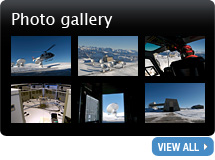The Pico Veleta observatory radio telescope is one of the world's most sensitive astronomical instruments. Located high in the Spanish Sierra Nevada where atmospheric water content is at a minimum, the telescope is ideally positioned to capture millimeter wavelength signals from the cosmos.
Mapping the cosmic signals
Signals are captured by the large 30 meter parabolic surface of the antenna and bounced off the surface towards the sub-reflector. The signal is then aimed at the receivers located inside the antenna cabin.
These incoming signals are extremely weak due to the great cosmic distances from the source. To amplify the signals, the receiver starts by converting them to a lower frequency. This signal is then combined inside the mixer-block with a locally produced signal at a frequency similar to that of the original signal. The super-conducting junction is the active element of the mixer. It sends out the difference between the two incoming signals, the so-called intermediate frequency, which is low enough to be amplified.
Located in the main building, an auto-correlator processes the signals removing any parasitic background noise. Finally, astronomers convert the incoming signals into data and reconstruct radio-images from the cosmic source.
Technical information
Built on a concrete pedestal, the 30 meter telescope rotates on an alt-azimuth mechanism with a tracking precision of less than 1 arcsecond.
The parabolic dish is comprised of 420 aluminium panels with a surface precision of 55 microns. This level of accuracy is achieved through high precision engineering processes and is further enhanced by mechanical adjustments of the panel positions themselves. Mechanical adjustments are also applied to the structure to compensate for the different gravitational forces it undergoes when the antenna is in either a vertical or horizontal position.
Positioned at the focal point of the parabola, the antenna cabin houses a variety of receivers allowing for different observations. Signals are distributed to the various receptors by a series of high precision mirrors.
Data transfer and antenna control between the receiver cabin and the control room is achieved with an array of low-loss cables which run down the pedestal in a spiral configuration allowing for the antenna's horizontal rotation.
Once inside the observatory's main building the signals are processed by a super-computer providing astronomers with usable data. Data is then processed and interpreted at the observatory or transferred to astronomers the world over.

